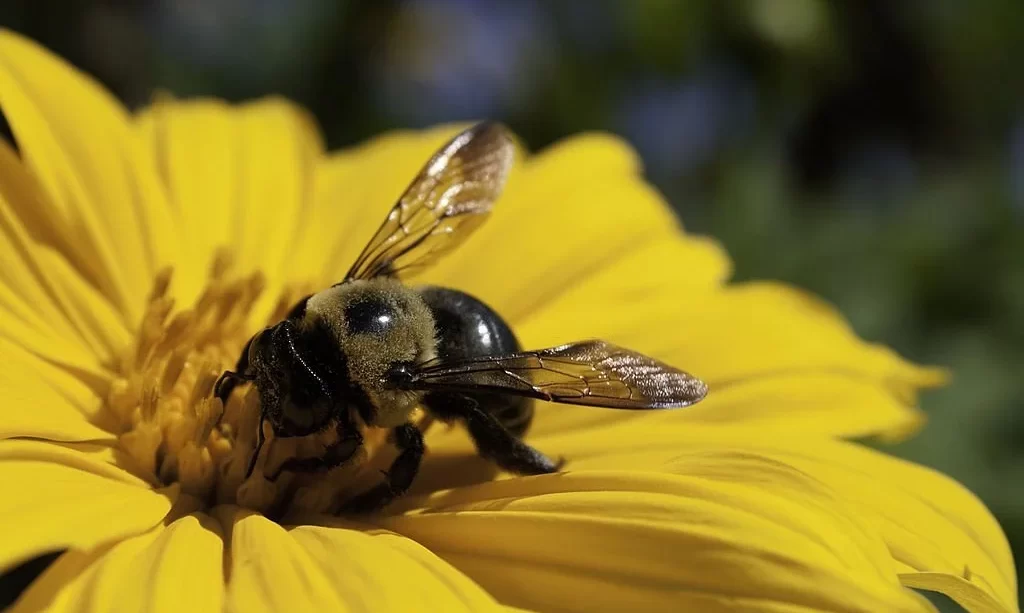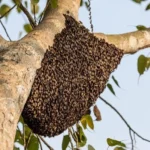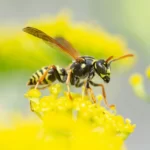Carpenter bees, with their distinctive appearance and drilling habits, often capture the curiosity of homeowners and nature enthusiasts alike. These solitary bees play a unique role in ecosystems and can sometimes become unwelcome visitors in wooden structures. One crucial aspect of understanding carpenter bees is unraveling the mystery of their lifespan. In this article, we delve into the intriguing world of carpenter bees and answer the question: “How long does a carpenter bee live”?
The Carpenter Bee Life Cycle
To comprehend the lifespan of carpenter bees, we must first explore their life cycle, which consists of distinct stages. Carpenter bees undergo a metamorphosis that shapes their existence from egg to adulthood. Here’s a breakdown of the carpenter bee life cycle:
- Egg Stage: The life cycle begins with a carpenter bee queen selecting a suitable nesting site, typically in softwood like pine or cedar. She bores a hole into the wood and lays eggs inside individual chambers. Each chamber contains a single egg and a supply of nectar and pollen for the developing larva.
- Larval Stage: After hatching from the egg, the larva feeds on the stored provisions. This stage is crucial for growth and development. Larvae are typically white, legless, and resemble small grubs. They remain in their chambers, protected by the wood, and grow over several weeks.
- Pupal Stage: Once the larva has reached a sufficient size, it pupates within the chamber. During this phase, it undergoes metamorphosis, transforming into an adult bee. Pupation can last several weeks to months, depending on environmental conditions and the bee species.
- Adult Stage: The mature adult carpenter bee emerges from the chamber, ready to contribute to the life of the colony or continue the cycle as a solitary bee. Adult carpenter bees are characterized by their robust bodies, dark coloration, and distinct sex-based roles within the colony.
Understanding the carpenter bee life cycle lays the foundation for comprehending their lifespans. In the following sections, we will delve deeper into the specific lifespan of adult carpenter bees, including differences between males and females, and explore the factors that influence their longevity in the wild and captivity.
Adult Carpenter Bee Lifespan
Now that we’ve explored the carpenter bee life cycle, let’s focus on the adult stage—the phase when carpenter bees actively engage with their environment, collect nectar and pollen, and contribute to their colonies. The lifespan of adult carpenter bees is a topic of interest for those seeking to understand these remarkable insects.
- General Adult Lifespan: On average, adult carpenter bees live for several weeks to a few months. However, the exact duration of their lives can vary depending on various factors, including species, environmental conditions, and gender.
- Female Carpenter Bee Lifespan: Female carpenter bees tend to live longer than their male counterparts. Their lifespan can range from a few weeks to several months, primarily because they are responsible for nest building, reproduction, and foraging.
- Male Carpenter Bee Lifespan: Male carpenter bees have a shorter lifespan compared to females. Their primary role in the colony is to mate with females, and they do not engage in nest building or foraging to the same extent. As a result, male carpenter bees typically live for just a few weeks.
- Factors Influencing Adult Lifespan: Several factors can influence the lifespan of adult carpenter bees. These include environmental conditions, such as temperature and humidity, as well as the availability of nectar and pollen sources. Additionally, the presence of predators and diseases can also impact the longevity of adult carpenter bees.
In the next section, we’ll take a closer look at the specific lifespan of male carpenter bees and the unique role they play in the carpenter bee colony.
Male Carpenter Bee Lifespan
Male carpenter bees, while essential for the reproductive success of the colony, have a relatively short lifespan compared to their female counterparts. Understanding the male carpenter bee’s lifespan provides insight into their role within the colony:
- Short Lifespan: Male carpenter bees typically have a brief adult life, lasting only a few weeks. Their primary purpose is to mate with female carpenter bees and ensure the colony’s future generation.
- Mating Behavior: Male carpenter bees actively patrol nesting sites, searching for receptive females. When they encounter a receptive female, they engage in courtship rituals and mating. After mating, their role in the colony is fulfilled.
- Limited Foraging: Unlike female carpenter bees, males do not engage in foraging for nectar and pollen or nest construction. Their focus remains on mating activities during their short adult life.
- Seasonal Variation: The lifespan of male carpenter bees can be influenced by seasonal changes. In some regions, they may emerge during specific times of the year when females are active, ensuring synchronized mating opportunities.
Understanding the relatively brief lifespan of male carpenter bees highlights the specialized nature of their role within the colony. In contrast, female carpenter bees, with their longer lifespans and multifaceted responsibilities, play a pivotal role in the survival and prosperity of carpenter bee colonies.
Female Carpenter Bee Lifespan
Female carpenter bees are the backbone of carpenter bee colonies, responsible for various essential tasks, including nest construction, reproduction, and foraging. Their lifespan is relatively longer compared to male carpenter bees, reflecting their multifaceted role within the colony:
- Extended Lifespan: Female carpenter bees typically live significantly longer than males, with lifespans ranging from a few weeks to several months.
- Nest Building: A significant portion of a female carpenter bee’s life is dedicated to constructing and maintaining nests. They excavate nesting galleries in wooden structures, where they lay eggs and provide nectar and pollen provisions for their offspring.
- Reproduction: Female carpenter bees are responsible for laying eggs, ensuring the continuation of the colony. They meticulously select suitable nesting sites, prepare chambers, and lay eggs within them.
- Foraging: Adult female carpenter bees actively forage for nectar and pollen, collecting essential resources to feed themselves and provision their offspring. This foraging behavior supports the overall growth and development of the colony.
- Colony Survival: The longevity of female carpenter bees is crucial for the success and sustainability of carpenter bee colonies. Their ability to reproduce and nurture the next generation is vital for the colony’s survival.
- Overwintering: In some regions, female carpenter bees may overwinter within their nests. This extended lifespan allows them to endure through the colder months, ensuring the colony’s continuity in the following spring.
Factors Influencing Carpenter Bee Lifespan
The lifespan of carpenter bees, both male and female, can be influenced by a range of factors, making it a dynamic and context-dependent aspect of their biology. Here are some key factors that can impact carpenter bee lifespan:
- Environmental Conditions: Temperature, humidity, and weather conditions play a significant role in carpenter bee lifespan. Ideal environmental conditions can extend their lives, while adverse conditions may shorten them.
- Availability of Resources: The presence of suitable nectar and pollen sources is essential for the survival of adult carpenter bees. Adequate forage ensures their nourishment and, consequently, their lifespan.
- Predators and Parasites: The presence of predators, such as birds, insects, and spiders, can pose a threat to adult carpenter bees. Parasitic insects may also impact their lifespan by targeting carpenter bee nests.
- Disease and Pathogens: Diseases and pathogens, including fungal infections and microbial agents, can affect carpenter bee health and longevity.
- Nest Site Quality: The quality and durability of the chosen nesting site can influence carpenter bee lifespan. Well-constructed nests provide better protection against environmental challenges.
- Human Activities: Human activities, such as habitat destruction, pesticide use, and wood treatment, can indirectly impact carpenter bee lifespan by altering their nesting sites and foraging areas.
By understanding these factors, researchers and conservationists can better assess the challenges faced by carpenter bees and develop strategies to support their populations and maintain their essential role in ecosystems.
Carpenter Bee Lifespan in the Wild vs. Captivity
Carpenter bee lifespans can vary between their natural habitats and captivity, with distinct factors influencing their longevity in each setting:
- Wild Lifespan: In their natural habitats, carpenter bees may face a range of environmental challenges and predators, which can impact their lifespan. Weather conditions, the availability of nesting sites, and the presence of natural enemies all play roles in determining how long carpenter bees live in the wild. Typically, wild carpenter bees have a lifespan of several weeks to a few months.
- Captivity Lifespan: Carpenter bees kept in controlled environments, such as research facilities or beekeeping operations, may experience different conditions. These controlled settings can provide consistent access to food sources, protection from predators, and stable environmental conditions. Consequently, carpenter bees in captivity often have longer lifespans compared to their wild counterparts. Under ideal conditions, they may live for several months.
Understanding these differences in lifespan between wild and captive carpenter bees sheds light on the various challenges and advantages these insects face in different environments.
Carpenter Bee Behavior in Their Final Days
As carpenter bees approach the end of their relatively short lifespans, they exhibit distinct behaviors and signs:
- Reduced Activity: Aging carpenter bees tend to exhibit reduced activity. They may spend more time resting and require longer periods to complete tasks they once performed swiftly.
- Nest Maintenance: In their final days, female carpenter bees may continue to maintain their nests, ensuring that the provisions for their offspring remain in good condition. This behavior reflects their commitment to the survival of future generations.
- Mating Activity: Male carpenter bees often intensify their efforts to mate with receptive females before the end of their lives. Their behavior becomes increasingly focused on finding suitable mates.
- Nesting Behavior: Female carpenter bees nearing the end of their lives may exhibit nesting behaviors, such as sealing off completed chambers or excavating new ones. This activity supports the next generation’s development.
- Signs of Aging: Physically, aging carpenter bees may show signs of wear and tear, such as frayed wings or faded coloration. These signs can be indicators of their advanced age.
Observing these behaviors and signs in carpenter bees provides valuable insights into their life cycles and contributes to our understanding of their biology and ecology.
Conclusion
In conclusion, the lifespan of carpenter bees, both in the wild and in captivity, varies depending on a multitude of factors. While the average lifespan of adult carpenter bees typically ranges from several weeks to a few months, this duration can be influenced by species, environmental conditions, gender, and the specific role each bee plays within the colony.
Understanding the nuances of carpenter bee lifespans not only deepens our knowledge of these intriguing insects but also highlights their importance in pollination and ecosystem dynamics. As essential pollinators, carpenter bees play a vital role in supporting plant diversity and food production.
By studying carpenter bee lifecycles and their behaviors throughout their lives, researchers and conservationists can work to protect and support these valuable members of the insect world. Carpenter bees, with their fascinating biology and ecological significance, continue to capture the interest of scientists and nature enthusiasts alike.



